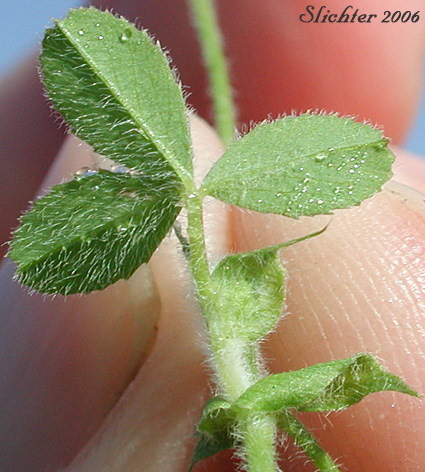 The photo at right shows a close-up of the hairy ventral surface of the trifoliate leaf of small-head clover as seen at Catherine creek.........May 1, 2005.
The photo at right shows a close-up of the hairy ventral surface of the trifoliate leaf of small-head clover as seen at Catherine creek.........May 1, 2005.
Small-head clover is a diminutive annual wildflower with several prostrate to erect stems arising from 10-70 cm high. The stems and leaves are sparsely to densely haired. The stipules are ovate to ovate-lanceolate in shape with toothed margins, and they measure up to half the length of the leaflets. The leaves are alternately arranged along the stems and are ternately compound. The leaflets are obovate-oblanceolate and measure 1.5-2.5 cm long with toothed margins, the teeth pointed forward. The lower surfaces of the leaflets are typically covered with long, straggly hairs.
The single head of flowers is 10 mm long and 10-60 flowered. The flower head is immediately subtended by a hairy involucre with about 10 shallow, triangular lobes (the lobes with entire margins). The calyx is about 4-7 mm long with the broad teeth ringed with a white, membranous margin and tipped with a long spine. The calyx is typically covered with numerous spreading, stiff to soft hairs and the teeth are about as long as the calyx tube. The corolla is white to pale lilac or rose in color and about as long as the calyx.
Small-head clover may be found in moist meadows, along sandy riverbanks and vernally moist hillsides that dry later in the spring. It may be found along the Pacific coast, in the lowlands and well up into the mountains.
Small-head clover may be found from southwestern British Columbia south to Baja California and east to Montana, Nevada and Arizona.
In the Columbia River Gorge, it may be found between the elevations of 100'-1800' from near Crown Point and Cape Horn in the west eastward to The Dalles, OR.